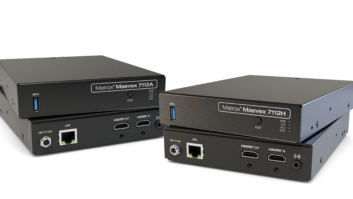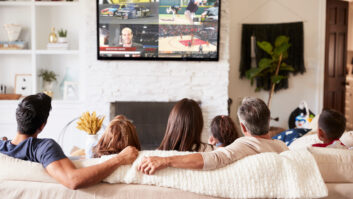
ThinkStock
Ever since they started appearing a few of years ago, I felt that curved TVs were, well, stupid. It seemed like one of those CES technology exhibitions that just screamed of, “Hey! Look what our engineers were able to do! Cool, huh?!” that I figured would run its course and die out. But that doesn’t seem to be the case.
While I can understand the geometry and increased edge-light benefits when using a curved screen with a front projection system with an anamorphic lens (the projected image having to travel further to reach the screen edges than the screen center on a flat screen just due to physics) having a curve on a direct-view LED TV just doesn’t make any sense to me. And the manufacturers’ claims that curved sets provided a more immersive viewing experience and a better picture across a wider range of seating positions seems like a stretch at best.
In fact, this *brilliant* ad from Vizio perfectly sums up my feelings about curved TVs.
Admittedly, a curved screen could provide a more immersive experience if it were A) Much larger and actually wrapped around the viewer(s) or B) The viewer (singular) sat significantly closer to the screen, such as when using a desktop monitor. However, a curved screen at the 50- to 65-inch sizes they seem to be focusing on and at typical seating distances seems illogical.
Besides just looking goofy on the wall (how many other curved things does the average homeowner have gracing their walls?) and sticking noticeably further off at the sides, which not only calls attention to itself but also more reveals the mounting hardware and cabling behind, I just can’t see any benefit to recommending and selling a curved TV to our customers.
But much like the fine-fight we constantly waged years ago where we tried convincing customers that Plasma TVs were the superior solution, and that they wouldn’t run out of gas and need recharging (sigh…), increasingly customers are coming in asking about curved TVs and wanting to know what we think about them after they’ve been through the Big Box store brainwashing indoctrination sales pitch on just how awesome curved sets are.
And to date, I can tell you exactly how many curved TVs my company has sold: zero.
Am I out of touch? Do I need to have my thinking corrected? Is the trouble really with me and not the curve?
To find out, I reached out to several of my “expert” friends in the industry—other reviewer and calibrator professionals that know far more about TVs than I ever will. I asked them to share their thoughts on curved TVs, good, bad or indifferent. While they overwhelmingly thought that curved sets were an overpriced gimmick, they also raised some good points about why curved TVs maybe aren’t so bad after all…
First, Chris Heinonen, Reviewer for The Wirecutter and Owner/Writer Reference Home Theater:
“I’m not a huge fan of the curved TVs, mostly because they add a price premium over the flat models but don’t add much if anything. For everything that a curved TV can fix, it adds another problem and costs more. While they do reduce some glare, they add different reflection artifacts that are distracting in their own way. You can notice the curve of letterbox bars on CinemaScope content pretty easily, which distracts me. Also the viewing angle gets reduced, since everyone is at a more extreme angle to the edge of the set when they are on the sides, so it isn’t as good for a crowd. The cost is the main reason I just don’t care about curved sets, since I’d rather save money for the same features in a flat model, or step up to a better flat model.”
Brent Butterworth, Independent Writing and Editing Professional:
“I don’t know the first thing about TVs, but I do know some things about the psychology and operating procedures of electronics manufacturers, and it seems to me there are several reasons manufacturers offer curved TVs:
1) Because they can (thanks to LED backlighting and OLED) and if manufacturers can, they usually do, whether or not it makes any sense technically.
2) Because of the decades-long grudge match between Samsung and LG, if one of them launches something the other often feels they have to follow suit. Thus, an idea gains instant market presence regardless of its merit.
3) Because TV picture quality has become so generally good that picture quality usually isn’t enough to persuade people to spend more on a TV. With curved TVs, the form factor is visually distinguished from that of the lower-end TVs, so when people walk into your living room they know right away you have enough money and prestige to afford an upscale TV. Sort of like if you have a big lion head on your wall, people know you have the money and vacation time to go on an African safari.
Note that none of these statements says anything about picture quality or a better user experience. Personally, if I’m spending more money, I want a more gratifying experience. This I find in the recent trend toward putting metal rings on cigars, where the depression in the ring provides a convenient way of holding the cigar and the added weight creates a more substantial, luxurious feel in the hand.”
Gregg Loewen, President, Lion Audio Video Consultants Inc., Lead THX Video Standards Instructor:
“[Curved screens are] pointless if you are not at the radius point from the curve. That being said, I think it would be pretty cool at 96 inches in size, and If I were sitting about 8 feet away. The main problem with LED is off-axis viewing problems, where blacks become elevated and colors wash out. This becomes visually worse with a curved screen. OLED displays, while maintaining off-axis black levels, [still suffer from washed out colors] when off axis. So while not as bad as with LED, it’s still a problem with curved screens.”
Tom Norton, Senior Editor and Technical Editor, Sound & Vision Magazine
“I’m sort of agnostic on curved screen sets, but I see them as a marketing feature. Their only performance impact is negative. They can produce odd reflections with room lighting, and in the case of a curved LCD set, they can exacerbate the off-axis viewing issues commonly experienced with such sets. As you move off center, the off-center angle becomes greater faster on the side that you’re moving to, while it changes more slowly on the far side. When sitting dead center with the lights off with a curved TV, I can take it or leave it. But other than the novelty, I don’t really see the point over a flat-screen set.”
Al Griffin, Contributing Technical Editor and Columnist, Sound & Vision:
“I am firmly in the camp that sees curved screens as a gimmick. Curved screens introduce geometric distortion at typical viewing distances and the immersive benefits they supposedly provide also disappear at typical viewing distances. What’s the point, then, aside from market differentiation?”
Kevin Miller, President of ISFTV, Product Development Consultant Consumer Television and ISF Calibrator:
“From a performance perspective, you can’t believe anything [manufacturers] advertise. They say things like ‘off angle viewing is better,’ but no, it’s actually worse. If you were really close to the display, the curve would kind of envelope you depending on the size of the screen, which could be OK I suppose. But I find the curve distracting when viewing from a regular seating distance. The reality is that this is a gimmick they are selling and making a premium on. The problem with talking people out of curved screens is that all the flagship, best-performing sets, especially from Samsung, are curved. When you go flat, you are giving up on performance, which is a shame. I don’t know how else to put it, but if you want a flat screen from Samsung, then you are going down to an edge-lit with poor black uniformity and not very good black level. The real cream of the crop is curved.”
Geoff Morrison, International Best-Selling Author and Technology Freelancer for CNET, Sound & Vision, Residential Systems, HDGuru.com, and Forbes:
“Curved TVs are 100-percent marketing. ‘Look, it’s different!’ They’re not curved enough for the distance at which most people sit. That said, it doesn’t matter. [David] Katzmaier (Senior Editor at CBS Interactive) found that, after a few days, you don’t even notice the curve. And they sure look different. Hell, I got the [Samsung Galaxy] S6 Edge [phone] because the curved OLED screen just looked cool, so why not? This post is a bit old, but it gives you an idea what I think.”
Michael Chen, Co-Creator THX Video Systems Calibration Program:
“Some of the advertising that I have seen regarding the curved screens have used the term ‘cinematic,’ as in in, ‘more like the cinema.’ Looking back into the history of cinema and why some of the screens were curved often had more to do with the science of projection. The projected image has to go through a lens, which leads to another question about the nature of optics: what shape is the lens on a projector, on a camera, on your cell phone? The lenses are circular and spherical, not flat.
“The nature of the lens on the projector adds a level of distortion into the projected image with the center of the lens being closer to the screen than the edges of the lens. If an image is projected onto a flat surface, there will be more image distortion in the corners and more focus issues. Project the same image onto a curved screen and the distortion and focus are better, making one of the reasons for using a curved screen being to overcome the distortions introduced by the projector lens into the system.
“On the home front, and back to the curved flat panels, there is no projector, and therein lies the problem. All that said, what does the curved display actually bring to the table as far as image quality is concerned? Curved panels are here more for marketing than for any real image quality improvement. I find (curved TVs) gimmicky and glare might actually be worse on these sets as it takes side glare and centers it more for the viewer.”
Dennis Burger, Reviewer, Residential Systems:
“I know I’m way in the minority on this, but I think curved TVs have their place. I’ve never been able to watch TV from [my wife’s] preferred seat closer to the edge of the room; it’s just too far off-axis for me to enjoy. But I noticed a curious thing the first time I was reviewing a curved TV. [While in my wife’s seat] I turned on the TV to listen to the Weather Channel and I noticed that all of a sudden, I didn’t find TV to be unwatchable. From my seat, sitting directly on-axis, it makes absolutely no difference; I cannot tell it from a flat screen no matter how much I squint. But from closer to the edge of the room [in her seat], I think the curve has some noteworthy benefits. I did some renderings in Sketchup to illustrate why curved TVs actually only make any sense for off-axis viewing. Same image, same screen real estate, same angle, the curve causes the screen to seem perceptually wider and gives a more direct view across a wider area of the screen.”
So, what are your thoughts? Is your company selling curved TVs? Do your customers like the way they look on the wall? Please to share comments below…







